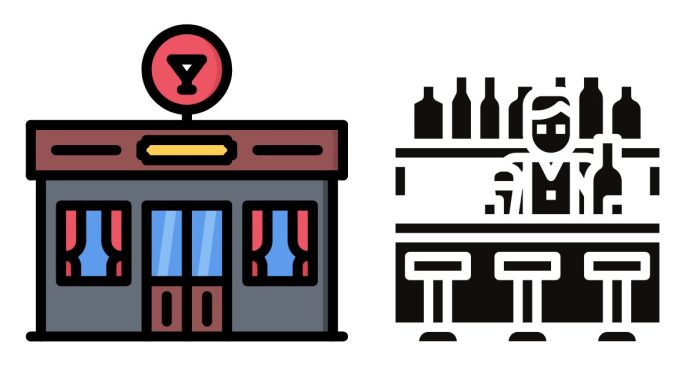The terms “bar” and “pub” are often used interchangeably, but there are a few key differences based on their cultural origins, atmosphere, and offerings. Here’s a breakdown:
1. Cultural Origins:
- Bar: The term “bar” originated in the United States and other parts of the world as a place where people could drink alcoholic beverages, typically at a counter (the “bar”) where drinks are served. It’s a more general term and can refer to any establishment that serves alcohol, from casual spots to more upscale venues.
- Pub: Short for “public house,” the word “pub” is primarily used in the UK and parts of Europe. Historically, pubs were places where the local community gathered, offering both drinks and food. Pubs often have a strong tradition of being cozy, communal spots for socializing.
2. Atmosphere and Ambiance:
- Bar: The atmosphere of a bar can vary widely. It can range from casual dive bars with a laid-back, no-frills environment to trendy, upscale cocktail bars with a more refined ambiance. Bars are typically centered around drinking, often with music or other forms of entertainment.
- Pub: Pubs generally have a more relaxed, cozy, and homey feel. Many pubs feature traditional décor like wooden furniture, dim lighting, and a more casual, welcoming environment. The focus is often on conversation and social interaction. Pubs tend to have a less flashy, more rustic or old-fashioned vibe compared to bars.
3. Food Offerings:
- Bar: While many bars serve food, it’s usually light snacks or finger food (like peanuts, chips, or nachos), especially in casual bars. In higher-end bars or cocktail bars, the food menu can be more extensive, but the primary focus is often on the drinks.
- Pub: A pub traditionally serves hearty, substantial food, and many have a full menu with meals like fish and chips, pies, burgers, and roasts. Pubs are often seen as places to go for a full meal in addition to drinks, with some even offering Sunday roasts or other cultural specialties.
4. Drinks Menu:
- Bar: Bars usually specialize in a wide variety of alcoholic beverages, including cocktails, beer, wine, and spirits. They might have a more diverse or creative drink menu, especially if it’s a cocktail bar or a more upscale venue.
- Pub: Pubs often have a more limited selection of drinks compared to bars, but they typically feature a good selection of beer (especially local ales or lagers), ciders, and wine. Some pubs also have cask ales or traditional beverages like stouts. Pubs may not focus as much on cocktails or elaborate drinks.
5. Entertainment:
- Bar: Bars may offer live music, DJs, dance floors, karaoke, pool tables, or other forms of entertainment. The focus in bars is often on a lively, energetic environment, and they might cater more to nightlife and social events.
- Pub: Pubs tend to have more low-key entertainment, if any. Many pubs might have quiz nights, pub games (like darts or pool), or occasional live music, but the environment is usually quieter and more focused on conversation and relaxation.
6. Clientele and Social Dynamics:
- Bar: Bars are often frequented by younger crowds or people looking to socialize in a vibrant, high-energy atmosphere. In many cases, bars are seen as more social or party-oriented, particularly in larger cities or nightlife areas.
- Pub: Pubs tend to attract a broader range of customers, from young to older patrons, and are often seen as a more community-oriented space. People might visit a pub to relax with friends or family, watch a game, or enjoy a meal. The vibe is generally more casual and family-friendly, especially in rural or suburban areas.
7. Hours of Operation:
- Bar: Bars usually stay open late into the night, sometimes until the early hours of the morning, depending on local regulations. They cater more to the late-night crowd looking for nightlife.
- Pub: Pubs typically have earlier closing times compared to bars. They might close around 11 PM or midnight, though this can vary depending on the country and the establishment.
8. Size and Design:
- Bar: Bars can be smaller or larger, with a strong focus on the bar counter area where drinks are served. They might have fewer tables and more standing room or areas for dancing and socializing.
- Pub: Pubs are generally larger in terms of seating and might have cozy booths, large tables for groups, and more open seating arrangements. The design is often rustic or traditional, with some pubs incorporating outdoor seating areas or beer gardens.
In Summary:
- Bar: More focused on drinking, nightlife, and sometimes entertainment. It has a diverse range of offerings, from dive bars to trendy cocktail bars.
- Pub: Primarily a place for food, drinks, and casual socializing. Pubs often have a more relaxed atmosphere and a stronger sense of community, with a focus on both food and drink.
While the differences can blur depending on the location and the specific venue, the main distinction is that a pub is generally more focused on being a cozy, community-oriented place to relax with food, while a bar is more focused on drinks and socializing, often in a livelier atmosphere.
Related posts:
- What does ringing in the ears mean spiritually?
- What Colors Do Blue and Green Make?
- How Long Does Raw Chicken Really Last in the Fridge?
- What are some amazing and memorable Valentine’s Day ideas that will leave a lasting impression?
- What is the definition of ‘friends with benefits?
- What is the difference between a bachelor’s and a degree?


